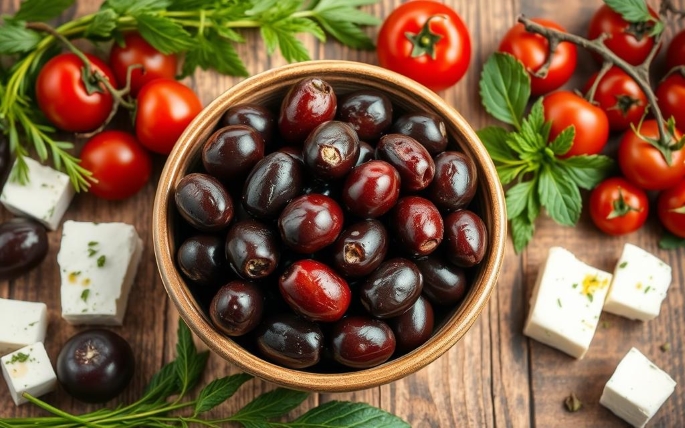Kalamata olives are truly tasty Greek gems, adding a unique flavor and texture to your favorite dishes. Originating from Greece, these olives have found a place in kitchens around the world as *kitchen staples* in Mediterranean cuisine. Their versatility allows you to incorporate them in various recipes, whether in salads, appetizers, or gourmet meals. With their robust flavor and numerous health benefits, it’s no wonder that kalamata olives are celebrated not only for their taste but also for their ability to enhance the Mediterranean diet.
Key Takeaways
- Kalamata olive are versatile and flavorful ingredients in Mediterranean cuisine.
- They provide health benefits, contributing to a balanced *Mediterranean diet*.
- These olives come pitted, saving preparation time in the kitchen.
- They can be used in a wide range of dishes, from salads to roasted meats.
- Choosing high-quality kalamata olive’s can elevate your culinary creations.
What Are Kalamata Olives?
Kalamata olives, a distinguished variety of Greek olives, hail from the picturesque region of Kalamata in the southern Peloponnese. Their signature almond shape and deep purple hue make them easily identifiable. These olives are treasured for their bold, fruity flavor, which enhances various dishes in Mediterranean cuisine.
Origin and Characteristics
The uniqueness of these olives starts with their origin. Grown primarily in Greece and recognized with Protected Designation of Origin (PDO) status within the European Union, this designation ensures that only olives from the Kalamata region may carry the name. While they are traditionally hand-picked to maintain quality, you can also find these olives cultivated globally, including the United States and Australia.
These olives belong to the Koroneiki cultivar, known not only for its olives but also for producing high-quality olive oil. Over 60 olive varieties exist in Greece, showcasing a rich agricultural heritage. Within this landscape, Kalamata’s olives offer a combination of attributes such as:
- Rich in healthy fats and antioxidants
- High in iron and vitamin A
- Intense flavor that surpasses other types
Kalamata olive undergo two primary preparation methods: the short method and the long method. The short method employs soaking them in water or weak brine, while the long method might involve brining for up to three months, developing a distinctive flavor and texture. These olives are commonly enjoyed in Greek salads, savory pasta dishes, and as toppings on artisan pizzas or charcuterie boards, playing a key role in various Mediterranean appetites.
Health Benefits of Kalamata Olives
these olives not only offer a unique flavor but also boast numerous health benefits tied to their rich nutritional profile. Understanding their components sheds light on why incorporating these olives into your diet can be advantageous.
Nutritional Profile
Each serving of kalamata olives delivers a variety of essential nutrients. A serving of about 38 grams, usually five olives, contains:
- Calories: 88 (4% DV)
- Total Fat: 6 grams (8% DV)
- Carbohydrates: 5 grams (2% DV)
- Dietary Fiber: 3 grams (11% DV)
- Sodium: 240 mg (10% DV)
- Protein: 5 grams (10% DV)
This diverse nutritional profile makes kalamata olives a notable source of healthy fats, particularly heart-healthy monounsaturated fatty acids like oleic acid, which may contribute to lowering heart disease risk. Furthermore, significant amounts of minerals such as iron, calcium, and copper can support overall health, reducing the chances of anemia and enhancing bone strength.
Brined Olives and Sodium
While brined olives add a delightful tang to your meals, they often come with increased sodium content. A typical serving can provide approximately 240 mg of sodium, which accounts for 10% of the recommended daily intake for a 2,000-calorie diet. This emphasizes the importance of moderation, especially for individuals managing high blood pressure.
Incorporating kalamata olives into your daily routine allows you to enjoy their myriad health benefits. Keep in mind the sodium content of brined varieties, allowing for a balanced inclusion in your diet. With their robust nutritional profile, these olives can contribute positively to your overall wellness.
Using Kalamata Olives in Your Kitchen
Kalamata olives are not just a delicious component of Mediterranean cuisine, they also elevate gourmet foods and enhance the flavors of various recipes. Their unique taste makes them a staple in many kitchens, providing versatility for a wide range of dishes.
Gourmet Foods and Recipes
Using kalamata olives opens up a world of culinary possibilities. From antipasto ingredients to pizza toppings, their rich flavor can complement many types of gourmet foods. Consider incorporating them into your next meal with the following suggestions:
- Antipasto Platters: Create an inviting array by combining kalamata olives with cheeses, cured meats, and marinated vegetables.
- Pasta Dishes: Toss kalamata olives into your favorite pasta recipes for an added depth of flavor.
- Salad Dressings: Blend kalamata olives into dressings for a savory kick that enhances your salads.
- Pizzas: Use kalamata olives as a topping for Mediterranean-inspired pizzas, pairing beautifully with feta and artichokes.
Kalamata olives not only bring taste and texture to each dish, but they also pack nutritional benefits that cater to health-conscious eaters. They are rich in iron and vitamin A, making them not just a treat for the palate but also for your overall well-being.
Incorporate these olives into your cooking repertoire to explore their potential fully. With ten different recipes featured, your culinary adventures with kalamata olives can be diverse and satisfying.
Gourmet Foods and Recipes
- Antipasto Platter
- Main Ingredients: Kalamata olives, feta cheese, salami
- Preparation Time: 10 minutes
- Pasta Salad
- Main Ingredients: Pasta, kalamata olives, cherry tomatoes, basil
- Preparation Time: 20 minutes
- Greek Pizza
- Main Ingredients: Pizza dough, kalamata olives, feta, spinach
- Preparation Time: 30 minutes
- Kalamata Olive Dressing
- Main Ingredients: Olive oil, kalamata olives, balsamic vinegar
- Preparation Time: 5 minutes
These delicious olives not only add flavor but also remind you of the rich culinary traditions of Greece, where they have been cherished for over five thousand years. For a culinary experience that delights the senses, look no further than kalamata olives in your kitchen.
Kalamata Olives: Versatile Ingredient for the Mediterranean Diet
Kalamata olives offer a delightful way to enhance your meals while aligning with the principles of the Mediterranean diet. These olives are not only packed with flavor but also provide numerous health benefits, making them a perfect fit for your snacking and meal preparation.
Healthy Snack Ideas
Incorporating Kalamata olives into your diet can elevate your healthy snacks. Here are some enjoyable ways to enjoy them:
- Pair with whole-grain bread or crackers for a nutritious bite.
- Mix into a cheese board with feta for a touch of Mediterranean flavors.
- Add to a fresh salad, balancing the greens with their robust taste.
- Create a tapenade by blending olives with garlic, capers, and herbs for dipping.
Pairing with Olive Oil
Pairing Kalamata olives with quality olive oil creates an exquisite flavor combination. This pairing not only enhances your dishes but also brings additional health benefits. Here’s why you should consider this mix:
- The monounsaturated fats in both olives and olive oil support heart health.
- Olive oil provides antioxidants, complementing the nutrients found in Kalamata olives.
- Drizzling olive oil over olives can heighten their distinct taste, making them a delicious starter.
Snack Ideas and Benefits
- Whole-grain bread with Kalamata olives: High in fiber and healthy fats
- Kalamata olives in salads: Rich in vitamins E and K
- Tapenade for dipping: Low-calorie option with intense flavor
- Cheese board with feta: Source of calcium and antioxidants
Embrace the Mediterranean diet with these delicious and nutritious snacks, leveraging the wonderful flavors and health benefits of Kalamata olives and their perfect pairing with olive oil.
Conclusion
Kalamata olives stand out as not only a delightful addition to your meals but also a nutritious choice that enriches your culinary experiences. With a unique flavor profile and a robust nutritional composition, these olives serve as an essential culinary staple in Mediterranean cuisine. They are a powerhouse of vitamins, minerals, and polyphenolic compounds that deliver numerous health benefits, including cardiovascular protection and anti-inflammatory properties.
By integrating kalamata olives into your kitchen, you open the door to a myriad of gourmet dishes and healthy snacks. The versatility of these olives allows you to explore the vibrant flavors of Mediterranean cuisine while improving your diet with every bite. Whether you incorporate kalamata olives in a salad, a tapenade, or enjoy them on their own, you are embracing a food rich in benefits that will not only satisfy your taste buds but also promote your overall well-being.
In essence, kalamata olive offer a remarkable way to enjoy delicious meals while reaping the health benefits they provide. Make them a staple in your pantry to discover how these remarkable olives can enhance your cooking and nourish your body.
FAQ
What are the different forms of Kalamata olive available?
Kalamata olive can be found in various forms, including whole, sliced, and pitted options. They are often available as brined olives, which enhance their salty-savory flavor, making them perfect for many dishes.
How can I include Kalamata olive in my diet?
You can enjoy Kalamata olive as a healthy snack, add them to antipasto platters, or use them as toppings on pizzas and salads. They can also be blended into dressings or incorporated into pasta dishes to elevate the flavor.
Are Kalamata olive suitable for a low-sodium diet?
While Kalamata olive provide numerous health benefits, they can be high in sodium due to the brining process. If you’re on a low-sodium diet, it’s essential to enjoy them in moderation and balance your overall salt intake.
How do Kalamata olive fit into the Mediterranean diet?
Kalamata olive are a fundamental component of the Mediterranean diet, promoting heart health due to their healthy fat content. Incorporating them into your meals supports a diet rich in whole foods and vibrant flavors.
What nutritional benefits do Kalamata olive offer?
Each serving of Kalamata olive is relatively low in calories and contains healthy fats, dietary fiber, and various antioxidants. They provide about 35 calories and 2g of dietary fiber which contributes to overall digestive health.
Can I use Kalamata olives in cooking?
Absolutely! Kalamata olive are versatile and can be used in cooking to enhance a variety of dishes. They work well in pasta, salads, and as part of gourmet foods for your antipasto spreads.
What are the best ways to pair Kalamata olive for a simple snack?
You can pair Kalamata olive with whole-grain bread, add them to a cheese board, or drizzle them with quality olive oil for an easy yet delightful Mediterranean-inspired snack.

